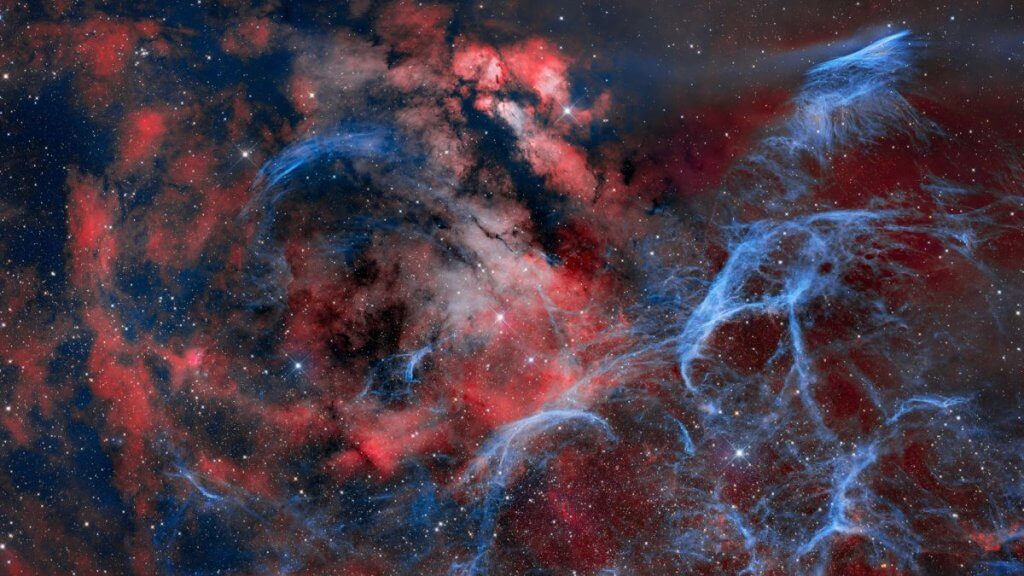This stunning wide field image captured by Vikas Chander shows what remains after an explosive death of a massive star — the Vela supernova remnant.
The dramatic scene arose about 11,000 years ago when a star in the constellation Vela went supernova. During the violent event, the star shined 250 times brighter than Venus and was so luminous it could be seen during the day, according to NASA. (opens in new tab)Though nowadays the star is long gone, its remnants are visible to eagle-eyed skywatchers in the Southern Hemisphere.
In the upper right of the frame, the blue-hued Pencil Nebula, or NGC 2736, shines against a backdrop of stars. The linear shape suggests that it is part of a supernova shockwave of debris that collided with a dense region of gas, causing its distinct glow, according to NASA.
Related: Night sky guide, what you can see tonight (maps)
The center of the image is dominated by an HII region called RCW 38. The embedded super star cluster is surrounded by billowing clouds of gas and dust. The term “super” is used to describe star clusters when they are more luminous and massive than young star clusters.
Vela constellation
The Vela constellation is visible in the Southern Hemisphere between latitudes +30 degrees and -90 degrees. It is named after the sails of the Argo Navis, the ship on which Jason and the Argonauts sailed on their quest for the Golden Fleece, according to the skywatching website Constellation Guide (opens in new tab). Vela was once part of a larger constellation called Argo Navis, but was divided up into three constellations in the 1750s by French astronomer Nicolas Louis de Lacaille; Vela (the sails), Carina (the keel) and Puppis (the stern).
Vela makes for an interesting skywatching target as it contains a number of intriguing stars and deep-sky objects including the Southern Ring Nebula (NGC 3132), the Gum Nebula and the Omicron Velorum Cluster (IC 2391), not to mention the Vela supernova remnant and the Pencil Nebula captured in this image by Chander.
Image specifics
Telescope: Takahashi E160ed
Camera: Zwo 6200mm pro
Mount: Software Bisque Paramount MX+
Observatory: Deep Sky Chile
Chander captured this image from the Deep Sky Observatory in Chile using a Takahashi E160ed telescope and Zwo 6200mm pro camera. It’s a two-panel mosaic spanning about six degrees.
“I planned a two-panel mosaic keeping in mind that I wanted the view to encompass the Pencil Nebula and RCW 38/39, while allowing RCW 38 to dominate the center.” Chander told Space.com.
“While the Pencil Nebula is oxygen-rich and the RCW nebulas are hydrogen-rich, I decided to image in the classical LRGB mode while also taking enough data on the oxygen and hydrogen filters to bring out the fine details.” Chander continued.
Chander’s Takahashi E160ed fast wide field scope accompanied by dark skies above the remote Chilean observatory allowed him to get a strong SNR (signal-to-noise ratio) resulting in a clean image.
Image processing
2 Panel Mosaic
L = 300s x 36, R= 300s x 24, G= 300s x 24, B= 300s x 24, Ha = 300s x 24, Oiii = 600s x 24
Total integration: 15hrs per panel, 30hrs total
Software: NINA, Pixinsight
If you’re looking for a telescope to view deep space objects our best telescopes for deep space guide may help. We also have a guide to astrophotography for beginners which covers everything from equipment to shooting modes and more. Our best cameras for astrophotography and best lenses for astrophotography can also help you prepare to capture your next skywatching sight.
You can see more of Chander’s work on his website www.vikaschander.com

